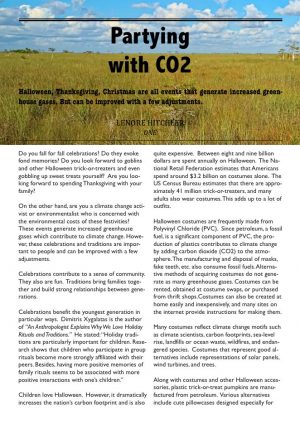 Do you fall for fall celebrations? Do they evoke fond memories? Do you look forward to goblins and other Halloween trick-or-treaters and even gobbling up sweet treats yourself? Are you looking forward to spending Thanksgiving with your family?
Do you fall for fall celebrations? Do they evoke fond memories? Do you look forward to goblins and other Halloween trick-or-treaters and even gobbling up sweet treats yourself? Are you looking forward to spending Thanksgiving with your family?
On the other hand, are you a climate change activist or environmentalist who is concerned with the environmental costs of these festivities? These events generate increased greenhouse gases which contribute to climate change. However, these celebrations and traditions are important to people and can be improved with a few adjustments.
Celebrations contribute to a sense of community. They also are fun. Traditions bring families together and build strong relationships between generations.
Celebrations benefit the youngest generation in particular ways. Dimitris Xygalatas is the author of “An Anthropologist Explains Why We Love Holiday Rituals and Traditions.” He stated: “Holiday traditions are particularly important for children. Research shows that children who participate in group rituals become more strongly affiliated with their peers. Besides, having more positive memories of family rituals seems to be associated with more positive interactions with one’s children.”
Children love Halloween. However, it dramatically increases the nation’s carbon footprint and is also quite expensive. Between eight and nine billion dollars are spent annually on Halloween. The National Retail Federation estimates that Americans spend around $3.2 billion on costumes alone. The US Census Bureau estimates that there are approximately 41 million trick-or-treaters, and many adults also wear costumes. This adds up to a lot of outfits.
Halloween costumes are frequently made from Polyvinyl Chloride (PVC). Since petroleum, a fossil fuel, is a significant component of PVC, the production of plastics contributes to climate change by adding carbon dioxide (CO2) to the atmosphere. The manufacturing and disposal of masks, fake teeth, etc. also consume fossil fuels. Alternative methods of acquiring costumes do not generate as many greenhouse gases. Costumes can be rented, obtained at costume swaps, or purchased from thrift shops.Costumes can also be created at home easily and inexpensively, and many sites on the internet provide instructions for making them.
Many costumes reflect climate change motifs such as climate scientists, carbon footprints, sea-level rise, landfills or ocean waste, wildfires, and endangered species. Costumes that represent good alternatives include representations of solar panels, wind turbines, and trees.
Along with costumes and other Halloween accessories, plastic trick-or-treat pumpkins are manufactured from petroleum. Various alternatives include cute pillowcases designed especially for children, canvas bags, and shopping bags that kids can have fun decorating. Halloween is the second-biggest decorating holiday of the year. According to the US National Retail Federation (NRF), $2.7 billion is spent on decorations. Their production and disposal contribute to global warming. However, decorations can be created from non-toxic recycled items.Besides enjoying Halloween themed decorating and dressing up for trick-or-treating, candy is another primary source of Halloween joy.
Unfortunately, the production of so much candy contributes to climate change. According to the NRF, $2.6 billion is spent on candy annually. In 2018, approximately 300,000 tons of candy were sold. The average trick-or-treater receives between five to 10 pounds of candy. This amounts to a large amount of sugar.
Sugar production generates quite a bit of greenhouse gases, thereby contributing to climate change. Fossil fuel-based fertilizers are applied to sugar crops. Using fossil fuels to apply pesticides also increases CO2.
According to the World Wildlife Fund, it takes from 750 to 5,000 gallons of water to grow a single acre of sugar cane. Greenhouse gases are produced if irrigation is used and is powered by fossil fuels. Deforestation to clear land for sugar cane plantations results in the release of CO2.

The Everglades, Florida (USA). Photo credit: Daniel Kraft
Additionally, new sugar plantations are not as effective at storing CO2 as the original rainforest.
Sugar consumed in the US comes from either sugar beets or sugar cane. Sugar cane that is grown in southern Florida contributes to climate change. Leonard Scinto is an environmental scientist at Florida International University. He stated that the Everglades Agricultural Area, which has been cleared for several crops, including sugar cane, has lost two-thirds of its soil. This soil is then exposed to air, resulting in the release of CO2.
Sugar cane fields are frequently burned during harvesting. The article “Greenhouse Gas Emission Associated with Sugar Production in Southern Brazil” was published in Carbon Balance and Management. The authors reported that 1.21 tons of CO2 equivalent were produced for each burned hectare (2.47 acres) of land.
Both sugar beets and sugar cane undergo a refining process that includes washing, crushing, heating, filtering, clarifying, crystallizing, and drying. Transporting that sugar also consumes energy. All of these processes together produce a lot of CO2. According to USA Market Data, 3.93 kilograms (approximately 8.6 pounds) of CO2 equivalent is produced for each kilogram (approximately 2.2 pounds) of refined sugar cane.
According to the Food Research Collaboration at the University of London, the carbon footprint of US beet sugar is 1040 grams (approximately 2.2 pounds) of CO2 equivalent for 1 kilogram of beet sugar. Sugar beets are a better source of sugar because they are grown in temperate areas, which means that rain forests do not have to be destroyed. Thus, sugar beet production does not cause as much climate change as sugar cane.
Sugar tastes great, and people love sweet candy. However, honey is a better alternative.
Honey can be produced in temperate climates resulting in the preservation of rain forests. Neither fertilizers nor irrigation is necessary. Thus, honey has a lower carbon footprint than table sugar.
The article “Carbon Footprint and Air Emissions Inventories for US Honey Production: Case Studies” was published in The International Journal of Life Cycle Assessment. Honey’s carbon footprint was estimated to be from 0.67 kilograms (1.47 pounds) to 0.92 kilograms (approximately 2 pounds) of CO2 equivalent per kilogram of honey.
Halloween candy frequently contains chocolate, which also has a high carbon footprint. Unfortunately, statistics from different sources vary on the size of the carbon footprint of chocolate. Finding the carbon footprint of chocolate manufactured in the US is difficult. A Canadian article stated that the carbon footprint of a 49-gram (approximately 1.7 ounces) chocolate bar was 169 grams (almost 6 ounces) of CO2. Cadbury, a British company, also estimates that 169 grams of CO2 equivalent are produced for every 49 grams of their dairy milk chocolate bar.
This calculation includes cocoa, milk, sugar, packaging, and distribution, but not from land-use change. Cadbury estimated that land-use changes add 3.45 grams (0.21 ounces) of CO2 per gram (0.035 ounces) to the carbon footprint of chocolate.
The University of Manchester published a report in Food Research International in 2018. The report found that the global warming potential of milk chocolate is 3.39 kilograms (7.4 pounds) of CO2 equivalent per 1 kilogram (2.2 pounds) of chocolate.
Additional evidence of the high carbon footprint of chocolate came from a University of Oxford study published in Science. The greenhouse gas emissions per 1 kilogram of chocolate were 19 kilograms (41.8 pounds).
To put this in perspective, the production of beef was found to emit 60 kilograms (approximately 132 pounds) per 1 kilogram, and one kilogram of cheese emitted 21 kilograms (approximately 46 pounds). The study also found that a chocolate bar from a deforested rainforest area resulted in more CO2 production than a serving of low-impact beef. Even though these different studies vary in actual numbers, they show that chocolate has a high carbon footprint.
In addition to the milk used in making milk chocolate, chocolate bar production itself, and transportation, deforestation to create new cocoa plantations also contributes to climate change. Additionally, replacing rain forests with palm oil plantations to provide the palm found in chocolate bars also increases deforestation.
The article “Deforestation and its Extreme Effect on Global Warming” published in Scientific American reported that deforestation is responsible for approximately 15% of global CO2 emissions. Removing trees results in increasing CO2 levels. It also eliminates the potential of those trees to absorb future CO2. According to the World Resources Institute, if tropical deforestation were a country, it would rank third in CO2 emissions, behind China and the US. Deforestation to produce paper used for candy wrappers also generates CO2. Additionally, fossil fuel energy is used in both the manufacturing and disposal of wrappers.
Thus, Halloween candy contributes to climate change. Fortunately, there are better ways to give out sweet treats during Halloween. How about a Hallo-green party with friends and neighbours? Serve homemade goodies, eliminating packaging and its contributions to climate change. Honey makes an excellent sweetener. Fudges that are not made with chocolates are a delicious and environmentally friendly alternative. These fudges include both peanut butter and honey fudge and fruit fudge made with frozen locally grown fruits and honey.
If you want to provide treats that are not sweet, distribute such items as pages from colouring books or children’s activities books. Hand out pretty dyed chicken feathers for art projects. Doling out coins is quite ecological since coins are recycled continuously.
Halloween pumpkins are an additional source of CO2. According to the US Department of Energy (DOE), nearly two billion pounds of pumpkins were grown in 2014. The manufacturing of both pesticides and fertilizers used on the crop produce greenhouse gases. Also, fertilizers applied to crops produce the greenhouse gas nitrous oxide, which is around 300 times more potent than CO2. An estimated 1.3 billion pounds of pumpkins are thrown out after Halloween. When they end up in landfills, they emit methane, which has 20 times the warming effect of CO2. Instead of wasting pumpkins, they can be used to make soup, bread, pudding, and pies. Roast the seeds. Feed pumpkins to chickens or other farm animals. Compost the remains.
Thanksgiving also results in high production of CO2 with its associated travel being particularly egregious. In 2019, the American Automobile Association (AAA) stated that for the Thanksgiving holiday, 55 million travellers planned trips of more than 50 miles.
AAA reported that 49.3 million would travel by car, and 4.45 million Americans planned on flying. To put this into perspective, Climate Central said that the carbon footprint of automobiles equals .802 pounds of CO2 per passenger mile. Air travel produces .505 pounds of CO2 per passenger mile, trains have .408 pounds of CO2, and bus travel produces .236 pounds of CO2. This adds up to quite a lot of CO2.
The traditional turkey roast is the centerpiece of Thanksgiving dinner. According to the National Turkey Federation, around 46 million turkeys are consumed every Thanksgiving. Research at Carnegie Mellon University found that the carbon footprint of a 16-pound turkey was 34.2 pounds of CO2. Side dishes of roasted Brussels sprouts, cranberry sauce, mashed potatoes, gravy, biscuits, and apple pie together generated another 34.2 pounds of CO2.
There are various methods to measure the amount of Thanksgiving turkey that gets discarded. The US Department of Agriculture estimates that 35% of turkey meat gets thrown out. An article in MarketWatch published in 2016 estimated that Americans tossed out $293 million worth of uneaten turkey. In 2018, Stefanie Feldstein, Population and Sustainability Director of the Center for Biological Diversity, wrote “Those Thanksgiving Leftovers?—They’re Killing the Planet.” She stated that about 200 million pounds of turkey are thrown away.
In other words, lots of turkey meat, costing a lot of money, and adding a lot of mass, end up in landfills where they emit lots of methane. Feldstein went on to say that more than 150 million pounds of potatoes, green beans and other vegetable side dishes are discarded. She added that an estimated 14 million pounds of dinner rolls would also be thrown out. Thanksgiving pumpkin pies also add to climate change. Approximately 50 million of Thanksgiving pies are consumed yearly. Fertilizers and pesticides are applied to the crop. Additionally, making the pies, transportation, and packaging and disposal of packaging generate CO2.

“The First Thanksgiving at Plymouth” (1914) By Jennie A. Brownscomb. Photo credit: Stedelijk Museum De Lakenhal
Fortunately, there are ways to make Thanksgiving dinner more climate-friendly. Give leftovers to guests, freeze them, or make soup. Compost anything not consumed. Start a new tradition of making Thanksgiving more like the original one. Linda Poppenheimer is the author of “The First Thanksgiving was a Green Event.” She wrote: Traditionally, the 1621 harvest feast celebrated by Plymouth Colony, is known as ‘The First Thanksgiving.’ By today’s standards, it was a green and low carbon event. It was a local affair. People walked to hunt, harvest, and between their homes and the harvest feast. … All the food was seasonal, local, and organic. … Fortunately, throw away packaging did not exist. … Nothing would have been thrown out or wasted. Written accounts by Edward Winslow and William Bradford provide the little information we have about the actual food eaten at the harvest feast. [These include] venison, waterfowl, wild turkeys, cod, bass, wheat, corn, and barley.
Thus, it is evident that our ways of celebrating Halloween and Thanksgiving contribute to climate change. However, it is not difficult to make the necessary improvements needed to lower the carbon footprint of these holidays. Fortunately, we can still have fun and enjoy these festivities in an environmentally friendly way.
Lenore Hitchler





